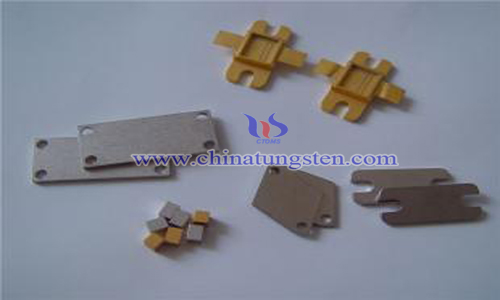How to Improve The Thermal Conductivity of Tungsten Copper Heat Sink
- Details
- Category: Tungsten Information
- Published on Wednesday, 24 October 2018 22:10
More than 60% of the cost of high-end semiconductor electronic devices, including LED, laser and microwave power devices, comes from packaging, and the key to packaging technology is heat dissipation. Heat dissipation not only affects the cost, but also affects the performance of semiconductor devices.

For semiconductor electronic devices, the need for good thermal conductivity and conductive fins, oxygen-free copper is the preferred, cheap, can meet the needs of most electronic devices. However, the thermal expansion coefficient of oxygen-free copper is more than three times larger than that of semiconductor. In the process of using the device, the difference and mismatch of thermal expansion coefficient will lead to the chip cracking failure of semiconductor electronic devices. Therefore, composite tungsten is needed to adjust the thermal expansion coefficient.
Some enterprises use a tungsten-copper radiator production system, using ultra-fine tungsten powder and copper powder composite, after sintering process close to full density and high thermal conductivity, conductivity tungsten-copper radiator, the process is as follows:
1.Preparation of tungsten-copper composite oxide powder: using ammonium tungstate and copper nitrate as raw materials, firstly dissolving copper nitrate in deionized water to form a solution, and then adding copper nitrate solution and concentrated nitric acid to the ammonium tungstate solution at the same time. After stirring for 30 to 90 minutes, the precipitate is taken out and calcined at 150 to 400 °C for 2 to 3 hours, and pulverized to obtain a tungsten copper oxide composite powder;
2.Reduction of W-Cu oxide composite powder: The W-Cu oxide composite powder was reduced by hydrogen in a gas permeable and drained tubular furnace to obtain uniformly dispersed nano-W-Cu composite powder. The reduction temperature was 650-750 °C, the reduction time was 1-1.5 h, and the hydrogen flow rate was 25-45 ml min.
3.Compression forming: the above-mentioned tungsten-copper composite powder is formed by conventional steel mold with a unit pressure of 100-250MPa, and then the blank is formed, and other forming methods such as isostatic pressing can also be adopted.
4.Sintering of ultra-fine grain tungsten-copper alloy: The compact obtained in step 3 was sintered in hydrogen at 1150-1250 C for 90-120 minutes, and the ultra-fine grain tungsten-copper alloy was obtained after sintering.
The tungsten copper alloy prepared by the above method has a copper content of 20wt%, a relative density of 98.0%-99.7%, an average grain size of 0.5-1.5 micron, a resistivity of 0.035~0.041×10-6 nm, and a heat conductivity of 280W/m*K.
- Tungsten Copper Manufacturer & Supplier, Chinatungsten Online: tungsten-copper.com
- Tungsten News & Prices of China Tungsten Industry Association: www.ctia.com.cn
- Molybdenum News & Price: news.molybdenum.com.cn
- Tel.: 86 592 5129696; Fax: 86 592 5129797; Email: sales@chinatungsten.com



 sales@chinatungsten.com
sales@chinatungsten.com